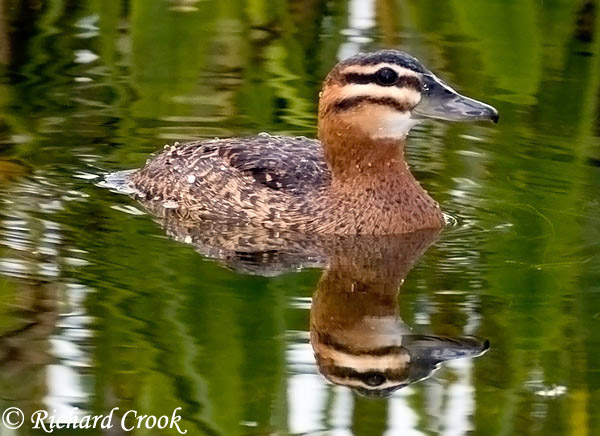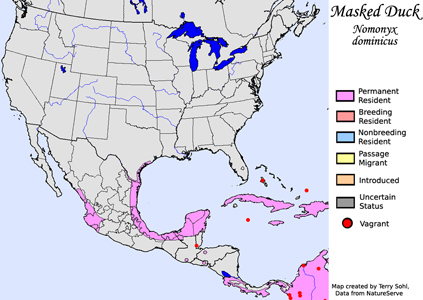| Length: 13.5 inches | Wingspan: 17 inches | Seasonality: Non-resident in South Dakota |
| ID Keys: Male dark ruddy color with black mask, pale bluish bill. Female (depicted below) brown overall with striped face | ||
 The
Masked Duck is a small duck of the American tropics, with a range that just
enters the U.S. in southern Texas and Florida. There, it is typically
uncommon, with fluctuating populations that seem to be associated with
longer-term weather patterns and availability of suitable wetland habitat.
Even when found in the U.S., they can often be difficult to spot, as they
usually prefer to hide in wetland vegetation, not coming out into open water
as much as most other duck species.
The
Masked Duck is a small duck of the American tropics, with a range that just
enters the U.S. in southern Texas and Florida. There, it is typically
uncommon, with fluctuating populations that seem to be associated with
longer-term weather patterns and availability of suitable wetland habitat.
Even when found in the U.S., they can often be difficult to spot, as they
usually prefer to hide in wetland vegetation, not coming out into open water
as much as most other duck species.
Habitat: In the small U.S. portion of their range, Masked Ducks are found in freshwater marshes and ponds, with open water surrounded by extensive areas of wetland vegetation. In Central and South America, they also can be found in wooded swamps.
Diet: Feeds mostly on plant material, including the roots, seeds and shoots of both aquatic and semi-aquatic plants. They will also eat aquatic insects, small mollusks, and small crustaceans.
Behavior: Forages by diving and swimming underwater in search of plant material and aquatic invertebrates. Will also feed on seeds and other plant material above the water, and will occasionally glean insects and mollusks from waterside vegetation.
Nesting: The nest of a Masked Duck consists of a bowl of grasses, reeds, and other herbaceous material, placed in marsh vegetation in shallow water. The female alone builds the nest, and incubates the eggs. The young are protected by the female upon hatching and leaving the nest, but young find their own food.
Song: Not a vocal species, typically silent. A courting male will give a long rolling series of notes.
Migration: Considered a permanent resident throughout its range, but local populations do tend to ebb and wane. After a series of wet years in south Texas, populations notably increase, although it's not sure if that's due to increased breeding success or movement of birds from Mexico into (newly created) suitable habitat during wet periods.
Interactive eBird Map: Click here to access an interactive eBird map of Masked Duck sightings
Similar Species: Ruddy Duck
Conservation Status: The IUCN currently lists the Masked Duck as a species of "Least Concern". The species does inhabit a very large range through the Americas, but doesn't seem to be common, and populations have been noted to be decreasing.
Further Information: 1) Cornell's Neotropical Birds - Masked Duck
2) Audubon Guide - Masked Duck
3) Whatbird - Masked Duck
Photo Information: Photo taken on July 16th, 2007 - Viera Wetlands in Florida - By Richard Cook - Photo licensed under Creative Commons Attribution-NonCommercial-NoDerivs 2.0 Generic License
| Click below for a higher-resolution map |
 |
| South Dakota Status: Non-resident in South Dakota |
Additional Masked Duck Photos (coming soon!!)
